Work and Energy
NCERT-CBSE-Class-9-Science-Chapter-11
Notes
|
Topics to be learn :
|
Sound : We hear sound from various sources, e.g. from humans, birds, machines, vehicles, TV, radio, etc. Sound is a form of energy which produces a sensation of hearing in our ears.
- This energy is in the form of waves.
- A medium is necessary for the propagation of sound waves.
- Sound waves give rise to a chain of compression (place of higher density) and rarefaction (place of lower density) in the medium.
Production of Sound :
Sound is produced due to vibrations of an object such as a stretched membrane or a string under tension.
- Vibration means a kind of rapid to and fro motion of an object.
- The sound of human voice is also produced due to vibrations in the vocal ord.
We can produce sound by striking the tuning fork, by plucking, scratching, rubbing, blowing or shaking different objects. They all produce sound due to vibrations.
Propagation of Sound :
Sound cannot travel without any medium. The medium can be defined as the matter or substance through which sound is transmitted. It can be solid, liquid or gas. Sound travels faster in solid than in any other medium.
- When an object vibrates, it sets the particles of the medium (solid, liquid or gas) around it in vibrations.
- The particles do not travel all the way from the vibrating object to the ear. A particle of the medium in contact with the vibrating object is first displaced from its equilibrium position.
- It then exerts a force on the adjacent particle. As a result of which, the adjacent particle gets displaced from its position of rest.
- After displacing the adjacent particle, the first particle comes back to its original position. This process continues in the medium till the sound reaches our ear.
- The source of sound creates a disturbance in the medium which travels through it. The particles of the medium do not move forward but the disturbance is carried forward.
This is propagation of sound in a medium, hence sound can be visualised as a wave. Sound waves require a medium to travel, so they are called mechanical waves.
Formation of Compression and Rarefaction in Air :
- When a vibrating object moves forward in air, it pushes and compresses the air infront of it, creating a compression which starts to move away from the vibrating object. When the vibrating object moves backwards, it creates rarefaction.
- Compression is the part of a longitudinal wave in which the particles of the medium are closer to one another than they normally are and it is the region of high pressure. It is denoted by C in the figure given here.
- Rarefaction is the part of a longitudinal wave in which the particles of the medium are farther apart than they normally are and it is the region of low pressure. It is denoted by R in the figure given here.
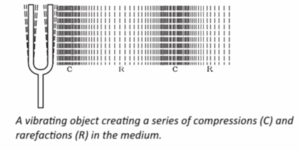
- As the object moves back and forth rapidly, a series of compressions and rarefactions is created in air.
- Thus, propagation of sound can be visualised as propagation of density variations or pressure variations in the medium as pressure is related to the number of particles of a medium in a given volume.
- More density of the particles in the medium gives more pressure and vice-versa.
- In compression region, the density and pressure is higher than that of rarefaction.
Sound Waves are Longitudinal Waves :
There are mainly two types of waves
(i) Longitudinal Waves :
- In longitudinal waves, the individual particles of the medium move in a direction parallel to the direction of propagation of the disturbance.
- The particles do not move from one place to another but they simply oscillate back and forth about their positions of rest.
- This is exactly how a sound wave propagates, hence sound waves are longitudinal waves.
- These waves can be produced in all the three media such as solids, liquids and gases.
The waves which travel along a spring when it is pushed and pulled at one end, are the longitudinal waves.
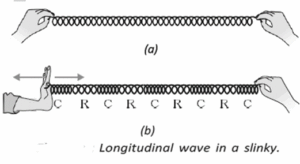
When coils are close together than normal, compressions (C) are observed in spring. When coils are farther apart than normal, rarefactions (R) are observed. A long flexible spring which can be compressed or extended easily is called slinky.
(ii) Transverse Waves :
- In transverse waves, the individual particles of the medium move about its mean position in a direction perpendicular to the direction of wave propagation.
- Example : Light is a transverse wave (but it is not a mechanical wave, i.e. it does not require a medium for its propagation).
- Transverse waves can be produced only in solids and liquids but not in gases.
- The waves produced by moving one end of a long spring or rope, up and down rapidly, whose other end is fixed, are transverse waves.
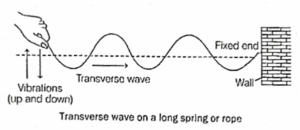
Characteristics of a Sound Wave :
Terms to Describe Sound Waves :
Sound waves can be described by its (i) wavelength (ii) frequency (iii) time period (iv) amplitude (v) speed
(i) Wavelength : The distance between the two consecutive compressions (C) or two consecutive rarefactions (R) is called the wavelength. Wavelength is the minimum distance in which a sound wave repeats itself. In other words, it is the combined length of a compression and an adjacent rarefaction.
- It is represented by a Greek letter lambda λ. Its SI unit is metre (m).
(ii) Frequency : The number of complete waves (or oscillations) produced in one second is called frequency of the wave. It is the number of vibrations that occur per second. Or the number of the compressions or rarefactions that cross a point per unit time.
- The frequency of a wave is fixed and does not change even when it passes through different substances.
- It is denoted by ν (Greek letter, nu). Its SI unit is hertz (symbol, Hz) named in honour of Heinrich Rudolf Hertz.
(iii) Time Period : The time taken by two consecutive compressions or rarefactions to cross a fixed point is called the time period of the wave. In other words, the time required to produce one complete wave (or oscillations) is called time period of the wave.
- It is denoted by symbol T. Its SI unit is second (s).
- The time period of a wave is the reciprocal of its frequency,
Time period (T) = 1/Frequency(ν)
(iv) Amplitude : The maximum displacement of the particles of a medium from their original mean positions on passing a wave through the medium is called amplitude of the wave.
- It is used to describe the size of the wave. It is usually denoted by the letter A. Its SI unit is metre (m).
- The amplitude of a wave is same as the amplitude of the vibrating body producing the wave.
- The amplitude of the sound wave depends upon the force with which an object is made to vibrate.
(v) Speed : The distance travelled by a wave in one second is called speed of the wave or velocity of the wave.
Under the same physical conditions, the speed of sound remains same for all frequencies.
- It is represented by letter v.
- Its SI unit is metre per second (m/s or ms-1).
Relationship between speed, frequency and wavelength of a wave :
Speed = \(\frac{Distance\,travelled}{Time\,taken}\)
Suppose distance travelled by a wave is λ (wavelength) in time T, then the speed is given by v = \(\frac{λ}{T}\)
We know that, frequency, ν = \(\frac{1}{T}\)
Therefore, v = λ x ν οr v = νλ
or Speed (velocity) = Frequency × Wavelength
Graphical Representation of a Sound Wave When a sound wave passes through air, the density of air changes continuously.
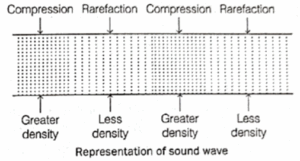
A sound wave in air has been represented by means of a density-distance graph as shown below
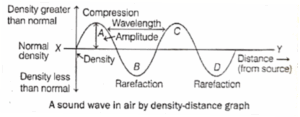
Characteristics of Sound :
A sound has three characteristics. These are loudness, pitch and quality (or timbre).
(i) Loudness : It is the measure of the sound energy reaching the ear per second. Greater the sound energy reaching our ear per second, louder the sound will appear to be.
If the sound waves have a small amplitude, then sound will be faint or soft but, if waves have a large amplitude, then the sound will be loud. In above figure shows the wave shapes of a loud and a soft sound of the same frequency.
Since, the amplitude of a sound wave is equal to the amplitude of vibrations of the source producing the sound waves, hence the loudness of sound depends on the amplitude of vibrations of the source producing the sound waves. Loud sound can travel a larger distance as it is associated with higher energy.
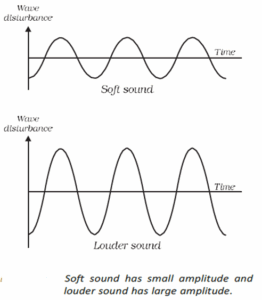
A sound wave spreads out from its source, as it moves away from the source, its amplitude as well as its loudness decreases.
- The loudness of sound is measured in decibel (dB).
- It depends on the sensitivity or the response of our ears.
Intensity : The amount of sound energy passing each second through unit area is known as the intensity of sound.
- Loudness and intensity are not the same terms.
- Loudness is a measure of the response of the ear to the sound.
- Even when two sounds are of equal intensity, we may hear one as louder than the other, simply because our ear detects it in better way.
- The SI unit of intensity is watt per square metre (W/m2).
(ii) Pitch or Shrillness : It is that characteristic of sound by which we can distinguish between different sounds of the same loudness.
Due to this characteristic, we can distinguish between a man's voice and woman's voice of the same loudness without seeing them.
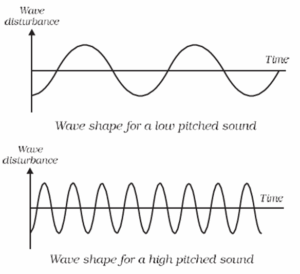
Pitch of a sound depends on the frequency of vibration. Greater the frequency of a sound, the higher will be its pitch. In other words, the faster the vibration of the source, the higher is the frequency and hence higher is the pitch, as shown in figure.
Thus, a high pitch sound corresponds to more number of compressions and rarefactions passing through a fixed point per unit time. Low pitch sound has low frequency and high pitch sound has high frequency.
Objects of different sizes and conditions vibrates at different frequencies to produce sounds of different pitches.
(iii) Quality or Timbre : The quality or timbre of sound enables us to distinguish
one sound from another having the same pitch and loudness.
- A sound of single frequency is called a tone.
- The sound produced due to a mixture of several frequencies is called a note and is pleasant in listening too.
- Noise is unpleasant to ear. Music is pleasant to ear and is of rich quality.
Speed of Sound in Different Media :
The speed of sound in air is about 344 ms-1at 22 ℃ and 331 ms at 0 ℃ and the speed of light in air is 300000000 ms-1 or 3 x 108 ms-1. Thus, speed of light is very high as compared to the speed of sound.
This is the reason why in the rainy season, the flash of lightning is seen first and the sound of thunder is heard a little later, though both are produced at the same time in clouds.
- The medium through which sound propagates can be a solid substance, a liquid or a gas.
- The speed of sound depends on the properties of medium through which it travels and the temperature of the medium.
- The speed of sound decreases when we go from solid to gaseous state.
- If temperature of the medium increases, then speed of sound also increases.
Reflection of Sound :
The bouncing back of sound when it strikes a hard surface is known as reflection of sound.
- It can be reflected from any surface whether it is smooth or rough.
- Sound waves follow the same laws of reflection as followed by light waves.
- The directions in which sound is incident and reflected make equal angles with the normal to the reflecting surface at the point of incidence and the three are in the same plane.
The laws of reflection of sound are as follows
- The incident sound wave (AO), the reflected sound wave (OB) and the normal (ON) at the point of incidence, all lie in the same plane.
- The angle of incidence (∠AON) of sound is equal to the angle of reflection (∠NOB) of sound.
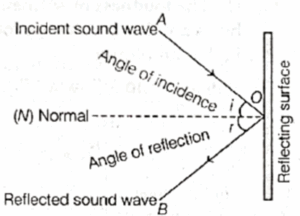
Echo :
Repetition of original sound due to reflection from a surface is called echo.
The sensation of sound persists in our brain for about 0.1 second. The speed of sound in air at 22 °C is 344 m/s.
The distance travelled by the sound in 0.1 s
= speed x time
= 344 × 0.1 = 34.4m
So, echo will be heard, if the minimum distance between the source of sound and the obstacle is 34.4/2 = 17.2 m
Hence, for hearing distinct echo, the minimum distance of the reflecting surface from the source of sound must be 17.2 m in air at 22 °C.
This distance will change with the change in temperature of air
Echoes may be heard more than once due to successive multiple reflections. The rolling of thunder is due to successive reflections of sound from a number of reflecting surfaces, such as clouds and the land.
Reverberation :
The persistence of sound due to repeated reflection of sound in a big hall or an auditorium is called reverberation.
- In reverberation, the intensity of sound and the time interval between the successive arrivals of the same sound go on decreasing with time.
- Excessive reverberation is not desirable as the speech of a speaker or the pitch of music cannot be heard clearly due to the mixing of reflected waves and direct waves produced after the production of earlier waves. To avoid these problems, reverberation should be reduced/controlled.
- For this the roof and walls of the auditorium are covered with sound absorbent materials such as compressed fibre boards, rough plaster or curtains. Even the material of the seat is chosen such that it absorbs sound waves to the desired extent.
Uses of Multiple Reflection of Sound :
The reflection of sound is used in the working of devices such as megaphone, horns, stethoscope and sound board.
These devices involve multiple reflections of sound waves.
(i) Megaphone and Horn : Megaphone is a large cone shaped device used to amplify and send the voice of a person in particular direction who speaks into it.
When a person speaks into the narrow end of the megaphone tube, the sound waves produced are prevented from spreading by successive reflections from the wider end of the megaphone tube, hence sound of his voice can be heard over a longer distance.
(ii) Stethoscope : It is a medical instrument used by doctors to listen the sound produced within the heart and the lungs in human body. The sound of heartbeats (or lungs) reaches the doctors ears by the multiple reflections of sound waves through the stethoscope tube.
(iii) Sound Board :
It is a concave board (curved board) placed behind the stage in big halls, so that sound after reflecting from sound board, spreads evenly across the width of the hall.
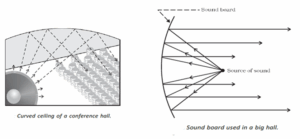
Generally, the ceilings of the concert halls, conference halls and cinema halls are also curved, so that sound after reflection reaches all corners of the hall.
Range of Hearing :
The average frequency range over which the human ear is sensitive is called audible range. The audible range of sound for human beings is from 20 Hz to 20000 Hz (20 kHz).
Children under the age of 5 and some animals such as dogs can hear up to 25000 Hz. As people grow older, their ears become less sensitive to higher and lower frequencies.
Infrasonic Sound :
- The sound of frequencies lower than 20 Hz are known as infrasonic sounds or infrasound, which cannot be heard by human beings.
- Earthquakes and some animals like whales, elephants and rhinoceroses produce infrasonic sound of frequency 5 Hz.
- It is observed that some animals get disturbed and start running here and there just before the earthquakes occur. This is because earthquakes produce low frequency infrasound before the main shock waves begin which possibly alert the animals and they get disturbed.
Ultrasonic Sound :
- The sounds of frequencies higher than 20000 Hz are called ultrasonic sounds or ultrasounds which cannot be heard by human beings.
- Dogs can hear ultrasonic sounds of frequency up to 50000 Hz. This is why dogs are used for detective work by the police.
- Bats, dolphins, and porpoises can produce ultrasonic sounds. Rats also play games by producing ultrasound.
Hearing Aid :
- A hearing aid is an electronic, battery-operated device used by individuals with hearing difficulties.
- It receives sound waves through a microphone and converts them into electrical signals amplified by an amplifier.
- These amplified signals are then sent to a speaker, who converts the amplified signals into sound and sends it to the ear for clear hearing.
Applications of Ultrasound
Ultrasounds are high frequency waves. They travel in straight line without bending around the corners. They can penetrate into matter to a large extent. Due to these properties, ultrasound is used in industry and in hospitals for medical purposes.
Some of the important applications of ultrasound :
(i) In Cleaning Minute Parts of Machines :
- Ultrasound is utilized to clean hard-to-reach parts like spiral tubes, odd-shaped machines, and electronic components.
- Objects are placed in a cleaning solution and ultrasonic waves are sent into the solution.
- Due to their high frequency, the waves stir the solution, causing dust, grease, and dirt particles to vibrate, loosen, and fall into the solution, resulting in thorough cleaning.
(ii) In Internal Investigation of Human Body :
- Ultrasound is a technique used to examine internal organs in the human body, such as the liver, gall bladder, pancreas, kidneys, uterus, and heart.
- It uses ultrasound waves to penetrate the body and reflect different tissues, converting them into electrical signals. These images are then displayed on a monitor or printed on film.
- Ultrasonography is particularly useful for examining fetuses during pregnancy to detect growth abnormalities and take necessary action to rectify them.
- Ultrasonic scanners are medical tools used to detect abnormalities like kidney stones, gall bladder stones, and organ tumors.
- They are also used for diagnosing heart diseases through echocardiography, which scans the heart from inside.
- Ultrasound can break kidney stones into fine grains, which are flushed out with urine, providing relief for patients.
(iii) In Industries :
- Ultrasound is used in industry for detecting flaws (cracks, etc.) in metal blocks without damaging them.
- Metal blocks are crucial in building structures like bridges and scientific equipment. However, they can be susceptible to cracks and flaws that can reduce their strength. These flaws can be detected using ultrasound, as an internal crack or hole prevents ultrasound from passing through.
- Ultrasound waves are allowed to pass through one face of the metal block, and detectors are placed on the opposite face to detect the transmitted waves. Even small defects can be detected by the reflected ultrasound waves, as shown in figure.
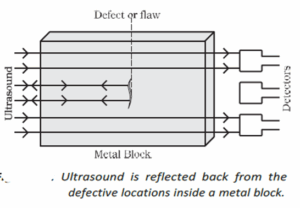
- Ordinary sound waves cannot be used for detecting the flaws in metal blocks because they will bend around the corners of the defective location and therefore, enter the detector.
Use of Ultrasonic Waves by Bats :
- Bats use echolocation to locate prey and fly at night by emitting and detecting ultrasonic waves.
- They use high-frequency or high-pitched squeaks to listen to the echoes from their path, allowing them to determine the distance of obstacles or prey.
- Bats can change direction or catch prey by changing the echo time.
- However, certain moths can hear the high-frequency squeaks of a bat and know where it is flying, allowing them to escape capture.
- This method is used by bats, tortoises, and dolphins to navigate their environment.
Click on below link to get PDF from store :
PDF : NCERT-Class-9-Science-Chapter-11-Sound - Notes
PDF : NCERT-Class-9-Science-Chapter-11-Sound - Solution
Main Page : NCERT-Class-9-Science – All chapters notes, solutions, videos, test, pdf.
Previous Chapter : Chapter-10-WORK AND ENERGY – Online Notes
Next Chapter : Chapter-12- IMPROVEMENT IN FOOD RESOURCES – Online Notes
